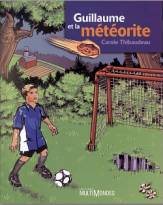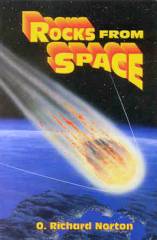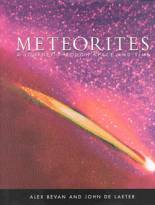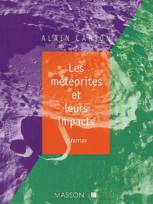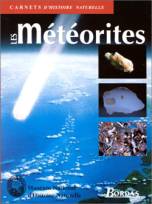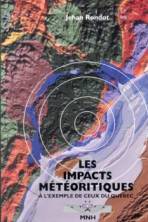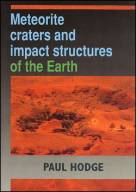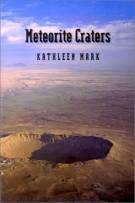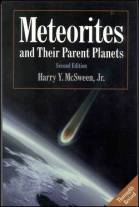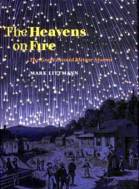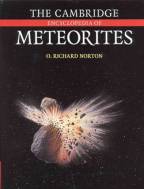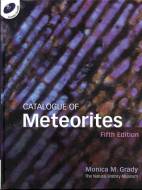
Annotated Reading List
Introduction to the world of meteorites
THIBAUDEAU, Carole. Guillaume et la météorite, Éditions MultiMondes, 2003, 92 pages. (in French)
Guillaume et la météorite is both a novel and a reference book for young people. In the middle of a soccer game, Guillaume sees a ball of fire crossing the sky. Burning with curiosity, he dreams of finding a rock from space. During an eventful summer vacation, he visits cousins in Saint-Robert where a meteorite has just fallen, explores the Charlevoix crater, and follows the comet Shoemaker-Levy-9 on television as it crashes into Jupiter. This book has lots of colour photographs and information about meteorites. The fact-filled capsules in the story give a complete and easy-to-understand picture of the science of meteors. This book is intended for 9 to 12 year olds.
NORTON, O. Richard. Rocks from Space , Mountain Press Publishing Company, 1994, 446 pages. (in English)
This fascinating book covers everything related to meteorites: falls, impact craters, recovery and identification of meteorites, the different families of meteorites, their origins, and meteorite hunters. The author answers all the questions we might ask about meteorites. The skillful writing style and interesting anecdotal passages make this book both a good read and a good source of scientific information. Except for a few chapters with more advanced scientific vocabulary, Rocks from Space is intended for all audiences. This publication includes more than 250 images, about fifty of which are in colour.
BEVAN, A. & DE LAETER, J. Meteorites: A Journey Through Space and Time. Smithsonian Institution Press / University of New South Wales, Sydney, 2002, 215 pages (in English)
The authors discuss the planets, asteroids, and comets from which meteorites come. They relate the meteoroids' long voyage in space, their fall to Earth, the recovery of meteorites, and the information these bodies from space bring us. The first chapter contains information on the customs and beliefs surrounding meteorites and how meteorites have been used in the past. The different themes are discussed in detail but the texts are easy to read. This book was written for a general audience. Technical language is reduced to a minimum. What makes this publication even more interesting is the quality of the images. The photographs are superb. The illustrations are easy to understand and attractive. A complete glossary and detailed index are included.
CARION, Alain. Les météorites et leurs impacts , Editions Masson, Paris, 1997, 222 pages. (in French)
The author, a famous French collector, invites us to discover meteorites: their classification, their age, their provenance, the craters they create, and some exceptional falls. The book includes a list of meteorites that fell in France, Belgium, Switzerland, and Canada as well as a description of the major collections in the world. A practical guide explains the laws relating to meteorite finds and how to put together a meteorite collection. This book makes good use of anecdotes and humour while presenting clear and accessible information.
Works for more experienced readers
ZANDA, Brigitte et al. Les Météorites , Muséum national d'Histoire naturelle, Bordas, 1996, 128 pages. (in French)
The first half of this book deals with meteorite falls, impact craters, mass extinctions, and the identification and origins of meteorites. These chapters are highly interesting and written in an easy-to-follow style. In the second part of the book, the authors address more knowledgeable readers as they examine several meteor-related sciences such as isotopic analysis and astrophysics. The illustrations are of very good quality but the images are often quite small, which prevents readers from appreciating their true value. The highly scientific and academic approach of this book makes it a work for advanced readers.
RONDOT, Jehan. Les impacts météoritiques à l'exemple de ceux du Québec , Publications MNH, 1995, 157 pages. (in French)
The book begins with an explanation of what meteorites are, where they come from, and how to recognize a meteorite impact site. The text becomes more complex in the following chapters as the author gives detailed descriptions of several impact sites in Quebec, including those at Manicouagan, Charlevoix, and Lac à l'Eau Claire. The author examines a scenario of a collision between an impacting object and the Earth and the possible effects of such a collision. Readers will need prior knowledge to understand the complicated graphics and long, technical sentences. This work is intended for motivated readers. Nevertheless, it is the only book that deals specifically with meteorite impacts in Quebec.
HODGE, Paul. Meteorite craters and impact structures of the Earth , Cambridge University Press, 1994, 124 pages. (in English)
In the first pages of the book, the author takes readers on a voyage around the world to discover meteorite craters. He discusses crater formation, the principal types of impact structures, and the signs of a meteorite impact. Close to 140 craters classified by continent are described. For each site, the location, size, age, and condition of the crater(s) are presented. Photographs and maps accompany the descriptions. For those who would like to go see a real crater, the descriptions include information about access to these fascinating sites.
MARK, Kathleen. Meteorite Craters , The University of Arizona Press, 1995, 288 pages. (in English)
This book goes beyond simply describing meteorite craters. The author recounts the scientific community's slowness to accept the existence of meteorite craters and to understand their significance. The lively writing style and the information that is more historical than technical make this an exceptional book. Nevertheless, more illustrations would have been appreciated.
McSWEEN, Harry. Meteorites and Their Parent Planets , Cambridge University Press, 1999, 309 pages. (in English)
This book is an accessible, well-rounded introduction to the world of meteorites and to the larger study of the formation and evolution of the solar system. The chapters are organized around the parent bodies of different types of meteorites. The final chapter discusses the importance of studying rocks from space. Meteorites and Their Parent Planets includes a number of tables and diagrams as well as beautiful black and white photos of meteorites from around the world. This book is suitable for a wide audienceómeteorite collectors, science students, and amateur astronomers will all find something of interest.
LITTMANN, Mark. The Heavens on Fire: The Great Leonid Meteor Storms, Cambridge University Press, 1998, 349 pages. (in English)
The Heavens on Fire is about meteors, in particular the Leonids, but it also examines the world of comets, asteroids, meteoroids, and meteorites. The author traces the history of meteor observation, presents the people who have made important discoveries in this field, and explains how meteors changed the course of life on Earth. Just one chapter is out of date, the one about observing the spectacular Leonid shower of 1999-2000. The texts are easy to understand for non-specialists. Knowledgeable readers looking for in-depth information about meteors will appreciate the technical details in the book's sidebars.
Specialized Books
NORTON, O. Richard. The Cambridge Encyclopedia of Meteorites . Cambridge University Press, Cambridge, 2002, 354 pages. (in English)
This book is a very thorough technical reference. The author provides detailed information about the chemical and mineral composition of different types of meteorites. Most of the photographs are close-ups and microscopic views of meteorites. The tables that summarize the information are practical and easy to follow. The anecdotal approach of Rocks from Space, by the same author, is not used in this encyclopedia. The Cambridge Encyclopedia of Meteorites is a must for readers who are already familiar with the subject and want to learn more.
GRADY, Monica M. Catalogue of Meteorites, Fifth Edition. Cambridge University Press, National History Museum, London, 2000, 689 pages. (in English)
This fifth edition of Catalogue of Meteorites, like the prior editions, is a reference volume for anyone with a keen interest in meteorites. This work presents an alphabetical list of more than 22 500 authenticated meteorites (to December 1999). For nearly 4 000 of them, the year, place of discovery or fall, and precise classification are provided along with an inventory of the institutions that possess fragments. There are no illustrations. A databank on CD-ROM comes with the book, making it possible to search by category and country.
